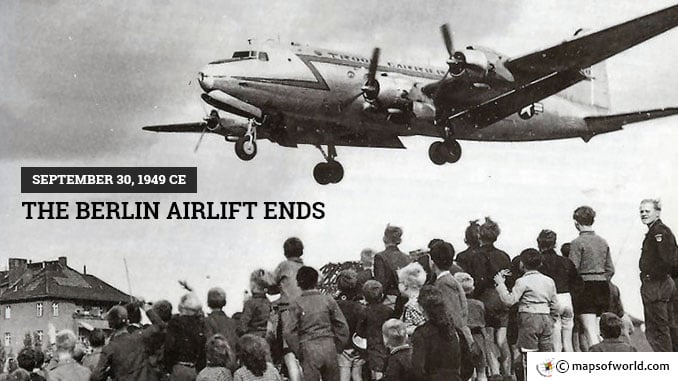In the wake of World War II, the four Allied powers — France, Great Britain, the United States and Soviet Union — divided the vanquished German state into zones which they would patrol. Three years later, as Cold War tensions heated up, Soviet officials in East Germany announced no goods would be allowed into Western-controlled Berlin by train or automobile, barring approved barrels of water. Desperate to keep the democratic districts of the city supplied, the American and British Air Forces launched an airlift that finally came to an end on September 30, 1949. Eager to help Europe rebuild after World War II, the United States initiated the Marshall Plan to provide aid to nations recovering from the devastation. At the same time, the British and American governments in West Germany opened discussions to help unify the economies in their respective zones. When the French joined in to produce a unified Trizone, Soviet officials in the northeastern quadrant of Germany began to suspect their Cold War enemies of colluding to roll back Communist influence. Early in 1948, trains arriving from the Democratic regions were stopped by Soviet soldiers for searches. Throughout the occupied nation, economic struggles were universal. With the Reichsmark faltering as Soviets drove the value down by distributing large quantities of freshly-minted bills, Germans exchanged goods and services instead of opting for the paper currency. Bent on making sure no German army rose to attack the Soviet Union again, it only seemed logical to Stalin’s policymakers to weaken the economy as much as possible. Their Western counterparts disagreed, working together to create the Deutsche Mark and announcing on June 18, 1948 its introduction in the Trizone would follow three days later. Three-quarters of Berlin, an island in the Communist sea of Soviet-occupied Germany, received more than 250 million of the notes to operate as official currency throughout the entire city. Fearing the new money would undermine control of their zone, the Soviets banned the Deutsche Mark and set out to create their own legal tender — the “Ostmark” — on June 22nd. Within hours, Communist officials rushed to the radio and newspapers to decry the actions of the United States, Britain and France while issuing a stark warning through diplomatic channels: the Soviets were willing to choke off Berlin in order to make sure the Ostmark was the only money used. On June 24th, the threat became reality. All surface roads from the Communist zone of Berlin into the Democratic areas but one were cut off. The Soviets shut down power generators, leaving the city in the dark. Food shipments into the Western-controlled areas were brought to a halt. There was no way in but by air. Seizing on a little-known tenet in the treaty signed by the four nations at the end of the war, the British and Americans coordinated a massive effort to ensure Berliners would be able to survive the blockade. With both forces depleted due to post-war reductions in troops and machinery, Western forces still managed to begin landing cargo aircraft filled with some 700 tons of goods at Berlin’s Templehof on June 28th. Before long, the two countries were coordinating take-offs every four minutes, cycling aircraft over hostile airspace and into the city as many as five times per day. By March 1949, deliveries exceeded 196,000 tons of supplies. Combining food, clothing and coal or other materials to generate heat, the British and Americans ensured the residents of Berlin were able to survive the cold winter months despite the meager rations available. On May 12, after several weeks of negotiations between the Soviets and Western representatives, the blockade was lifted at midnight. Trains and trucks immediately crossed the border bound for Berlin, greeted by exuberant crowds. Aiming to ensure citizens would have at least three months’ worth of supplies in the event of another Soviet action to sever Berlin from West Germany, flights continued until late July. Satisfied with the readiness of residents and the ability for the British and American Air Forces to mobilize quickly in the future, the Berlin Airlift officially came to a close on September 30, 1949. Over the course of fifteen months, more than 2.3 million tons worth of supplies had been delivered by over 278,000 flights into Berlin — 609 planes per day carrying an average of 8 tons each. Also On This Day: 420 – Catholic St. Jerome, who translated the Bible into Latin, dies 1935 – The Hoover Dam is dedicated 1954 – The USS Nautilus becomes the first nuclear-powered submarine 1966 – Botswana declares independence from Britain 2005 – Drawings of the prophet Muhammad appear in the Danish newspaper Jyllands-Posten, prompting protests
September 30 1949 CE – The Berlin Airlift Ends
In the wake of World War II, the four Allied powers — France, Great Britain, the United States and Soviet Union — divided the vanquished German state into zones which…
432
